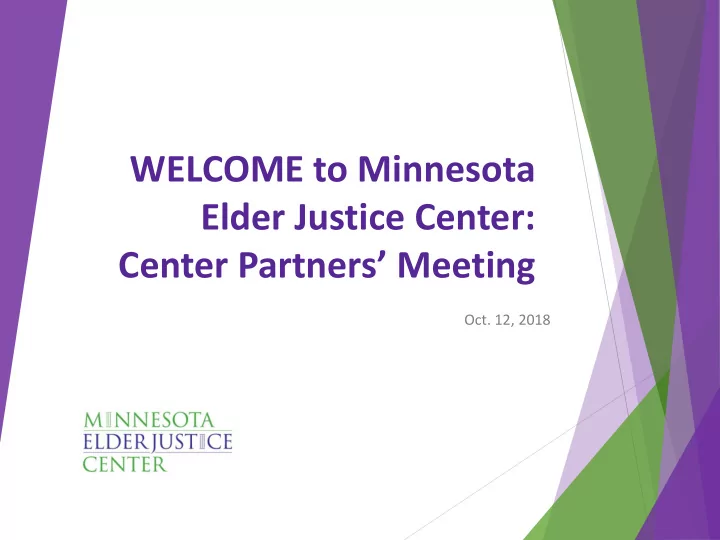

WELCOME to Minnesota Elder Justice Center: Center Partners’ Meeting Oct. 12, 2018
AGENDA • 2:00 – 2:15 | Introductions / Announcements • 2:20 – 3:10 | Minnesota’s Medicaid Fraud Control Unit • 3:10 – End | Public Health Responses to Elder Abuse Primary Prevention in Elder Abuse
MEJC Announcements – Surly Event • MEJC Surly Event – Oct. 29 • MEJC Webinar – October 30 at 11 am
MEJC Announcements • MEJC Surly Event – Oct. 29 • MEJC Webinar – October 30 at 11 am
Objectives • 3:15 – 4:00 | “Understanding Elder Abuse as a Public Health Issue” Attendees will: 1) Understand what makes Elder abuse a Public Health Crisis 2) Analyze how a public health approach can help with the prevention of Elder Abuse 3) Analyze policy considerations in light of treating Elder Abuse as a Public Health Crisis – including the steps stakeholders (state agencies, advocates, service providers, lawmakers, others) can take in creating a public health approach to preventing Elder Abuse
Background & Context Public Health Language has long been used by advocates to describe the problem Fighting Forest fires vs. Asking how the fires are being started Recent MN Senate Hearing on OHFC Improvements and Changes 59:20 (video)
Background & Context #2018MNCHC – Where is Elder Abuse Elder abuse is largely missing from the broader public health community conversations. Challenge is on us to build connections within that community.
Group Conversation: How do we prioritize a Public Health response focused on Primary Prevention Strategies? (1) What would a state-wide public-health response to elder abuse look like? (2) What policy changes/additions are needed to support a state-wide public health response to elder abuse?
Why is Elder Abuse a Public Health Crisis? Health Outcomes Consequences of Elder Abuse: Increased morbidity Increased mortality Years of Potential Life Lost Quality of Life
Quality of Life Declining functional ability Increased dependency and sense of helplessness Increased depression and psychological decline
Costs to society Survivors of elder abuse have higher rates of hospitalization and institutionalization ~$5.3 Billion Survivors have increased reliance on other public programs ~ $10 Billion ACL 2018; Connolly 2014
Primary, Secondary, Tertiary Prevention
Gaps in PH responses CDC, NIH, Private entities have spent billions to develop public health responses to child abuse and domestic violence compared to elder abuse Shortage of workforce trained to identify, address, prevent and study elder abuse Connolly, 2014
Gaps 10x number of pediatricians vs geriatricians (2013) Number of geriatricians declining Most pediatricians trained on recognizing child abuse Very few geriatricians are trained in recognizing elder abuse Eldercare Workforce Alliance, 2013
Growth of Older Adults The Administration on Aging expects that by 2030, the U.S. population over age 65 will have doubled from 2000, with older adults representing 19% of the population.
Needs Data Collection/Research Elder Abuse research*: NIA, $1.1 million (.0001% of budget) CDC, $50,000 (.0008% of budget) NIJ, $450,000 (+$1.2 million other DOJ funds) Prevention & Intervention Programs Evidence-based Outcome and Process evaluation Supportive Policy Infrastructure *Connolly, 2014
Components for Effective PH Program Implementation Innovation Technical Package Managing Performance Partnerships Communication Political Commitment Frieden, 2014
Society is like a building, we can improve it with support beams working together that keep everyone safe Adult Protective Services Advocacy Organizations Law Enforcement Financial Institutions Medical Staff Facility Staff Concerned Citizens
VAA Through the Lens of Prevention Out main policy responses in Minnesota focus on Secondary and Tertiary responses Example: VAA focuses mainly on responding to reports of abuse, neglect, and exploitation for a narrow subset of older (and vulnerable) adults who are at risk of abuse, neglect, financial exploitation
VAA Through the Lens of Prevention Policy Responses to other Public Health Problems focusing on Prevention “sin” taxes on alcohol and tobacco Limits on Sugary Soft Drink sizes Investment in Urban green spaces reduce crime and findings show it does not “spread” Understanding violence prevention as reducing opportunity
Group Conversation: How do we prioritize a Public Health response focused on Primary Prevention Strategies? (1) What would a state-wide public-health response to elder abuse look like? (2) What policy changes/additions are needed to support a state-wide public health response to elder abuse?
Contact Us Sean Burke | 612-412-2111 Minnesota Elder Justice Center 651-440-9300 www.elderjusticemn.org
Recommend
More recommend